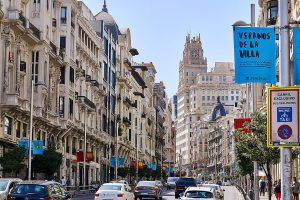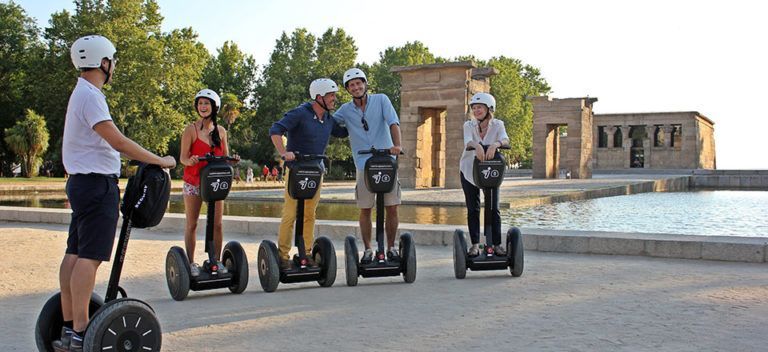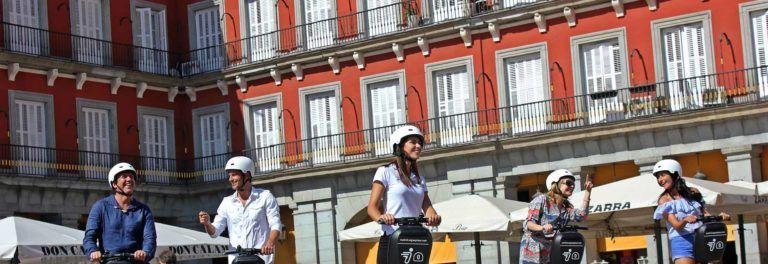Everything about the Royal Palace of Madrid
The Palacio Real de Madrid or Royal Palace of Madrid is probably, together with the Catedral de la Almudena, the most important work in size and history of the Spanish capital. Built in the old grounds of the Alcázar (Military fortress), is a work of pharaonic dimensions in the center of Madrid, and adjacent to the gorgeous Jardines de Sabatini. It was the king Felipe IV who ordered its construction and initially was projected to be the official residence of the Spanish monarchs, although to this day they have always lived in the Palacio de la Zarzuela. The Royal Palace of Madrid is used for state ceremonies and solemn acts.
Come and join us in this trip to the heart of Spanish history in Madrid. We invite you to know this majestic palace, which doubles in size the Buckingham or Versailles Palaces. A big piece of Madrid’s history that you cannot miss.
TABLE OF CONTENTS
The Royal Palace of Madrid: what to know
A little introduction
The Alcázar de Madrid was a royal palace that came from military fortresses that had been erected in that same spot in the year 850 by the Arab kings. The Alcázar burned down mysteriously during 1734 Christmas Eve, so a few years later, King Felipe IV ordered the construction of another palace in the same spot: The Royal Palace. Its 135,000 m2 and its 3,400 rooms make this Palace a world benchmark, both for its architecture and its size. The last inhabitant of the palace was Manuel Azaña, President of the Second Spanish Republic, who renamed it “National Palace”. During your visit, look for the famous “Despacho de Azaña”, next to the chapel.
A majestic and enormous palace
The Royal Palace of Madrid is in front of the Plaza de la Armería and next to the Plaza de Oriente, the beautiful Jardines de Sabatini and the Jardines del Campo del Moro. With its size and height, this enormous palace has hundreds of rooms, halls and special lounges, to the point that it would take literally three days to name them all. When you enter the palace, you get shocked by this lavish building, hallmark of the history, power and prestige of the institution.
The ground floor houses the Royal Library, the Royal Armory, the General Palace Archives and the Royal Kitchens. In addition to all the artistic works that the Royal Palace has, the Royal Library is one of the most incredible literary archives in the city. When you go up to the upper floor you will see the main staircase and the Alabarderos Hall, the Columns Hall or the Gasparini Chamber. The Royal Chapel, the Hall of Mirrors, the Porcelain Cabinet or the Throne Room and the Crown Hall, where we find Queen Maria Cristina’s crown. To finish with the visit of the top floor you can also see the old Cuarto de la Reina, Del Infante Don Luis, Queen María Luisa or Carlos IV.
With historical and priceless collections
As you walk through this architectural wonder you will see different art collections that are truly astonishing in terms of quality and historical value. A cultural heritage that can hardly be matched. Between the most outstanding painting collections, distributed along the halls of the house, the collection of tapestries from the XVIII century, the goldsmith or the luxurious furniture. Among the most noteworthy pieces of these collection, it stands out two Stradivarius Palentinos, a viola and a violoncello, made by the famous luthier Antonio Stradivarius. The clock collection has also very important pieces, gathered by the king Felipe II during the times of the Alcázar. One of them is from 1583, and it was made by the famous artist Hans de Evalo, in the shape of an oil lamp.
How do I get to the Royal Palace of Madrid? And when?
The Royal Palace of Madrid is in the southwest part of the city, in the Plaza de Oriente. To get there you can use the train and subway, stopping at Príncipe Pío, Opera or Plaza de España metro stations, although Opera metro station is the closest. From October to March and from April to September, the Palace is opened every day from 10 a.m. to 6 p.m. but remember that closing time, not only the doors but the lockers too, is done one hour before.
The days you won’t be allowed to visit it, either for national holidays or private event, take place on January 1st, January 6th, May 1st and December 25th. All these days, the Royal Palace of Madrid will remain closed for the whole day. On October 12th, Día de la Hispanidad, the Palace will close until 5:00 pm, and on December 24th and 31st it will be closed after 3:00 pm.
Price of the tickets depends on the areas of the palace you wish to visit, and if you do it individually or in groups. In addition, you need to register on their website to buy group tickets. The Royal Palace of Madrid receives almost one and a half million visitors per year, which makes it the seventh most visited destination in the entire country.
Is it worth it?
Most definitely! Although the guided tour is not an overly long visit, everyone who does it recommends it, as you can check yourself on the reviews posted on the internet. The good thing about the guided visit is that you learn everything about its halls, its history, all the things that happened between its walls and the different time periods it has survived. The diversity of halls and living rooms, the painting collection and the astonishing architecture are some of the reasons you shouldn’t miss this monument.
*** Extra tip
If your visit happens to be during the first Wednesday of the month (except in summer), you will have the chance to witness a spectacular ceremony: the changing of the guard. In the Plaza de la Armería, more than 450 soldiers participate in this event, including horses and canyons. A military song with explanations of what is happening sound in the speakers. It lasts two hours but it is totally worth it.








